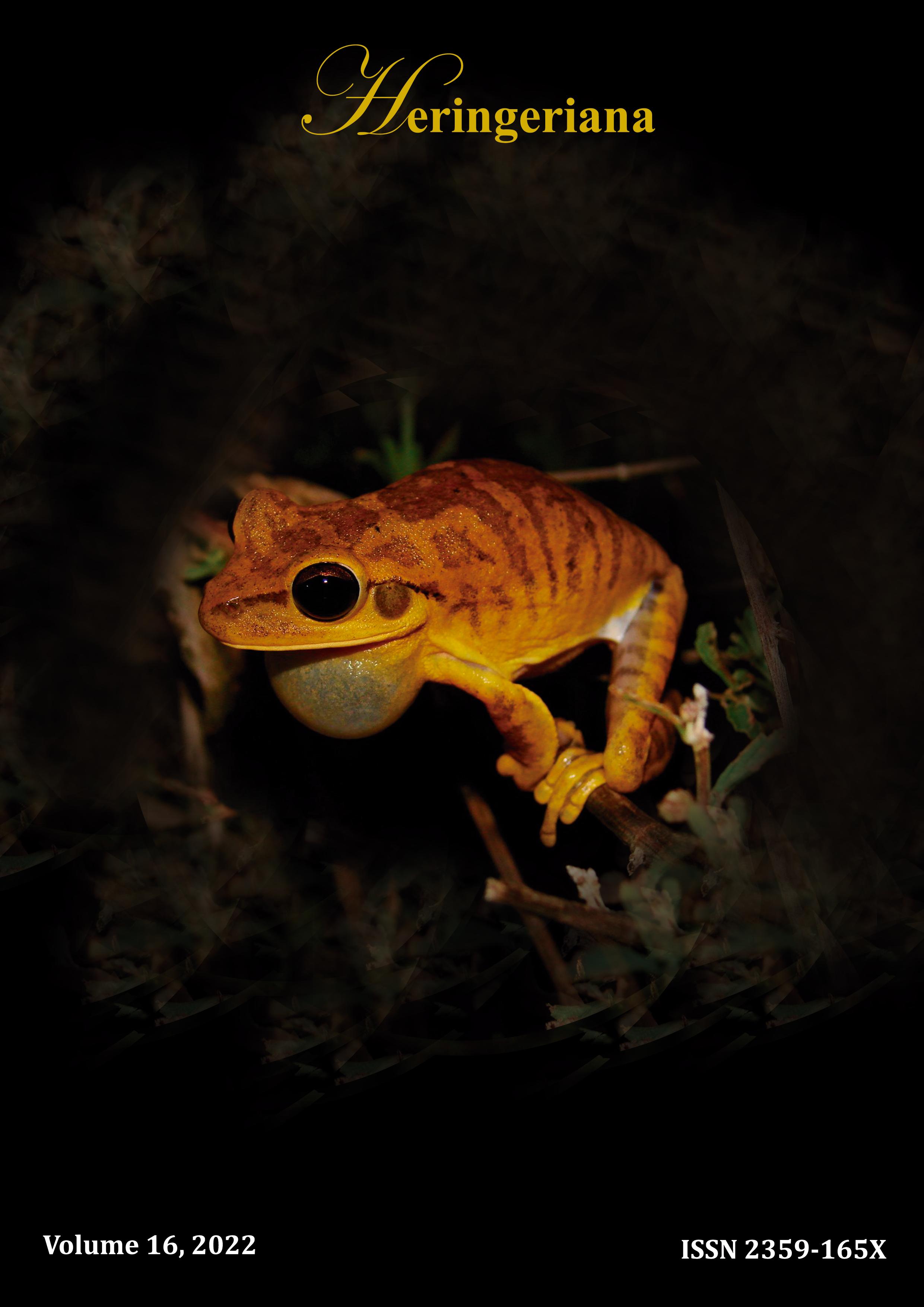Does habitat suitability affect flight-initiation distance in Burrowing owls?
DOI:
https://doi.org/10.17648/heringeriana.v16i1.917967Referências
Anselin, L. (1995) Local indicators of spatial analysis--LISA. Geographical Analysis 27: 93-115.
Baladrón, A.V., Isacch, J.P., Cavalli, M., Bó, M.S., Sacch, I., Avalli, M.C., María, S.B.. (2016) Habitat Selection by Burrowing Owls Athene cunicularia in the Pampas of Argentina: A Multiple-Scale Assessment Habitat selection by Burrowing Owls Athene cunicularia in the Pampas of Argentina: a multiple-scale assessment. Acta Ornithologica 51: 137-150.
Bateman, P.W., Fleming, P.A. (2011) Who are you looking at? Hadeda ibises use direction of gaze, head orientation and approach speed in their risk assessment of a potential predator. Journal of Zoology 285: 316-323.
Blumstein, D.T. (2006) Developing an evolutionary ecology of fear: How life history and natural history traits affect disturbance tolerance in birds. Animal Behaviour 71: 389-399.
Carrete, M., Tella, J.L. (2013) High individual consistency in fear of humans throughout the adult lifespan of rural and urban Burrowing owls. Scientific Reports 3: 1-7.
Carrete, M., Tella, J.L. (2017) Behavioral correlations associated with fear of humans differ between rural and urban burrowing owls. Frontiers in Ecology and Evolution 5: 1-9.
Cavalli, M., Baladrón, A.V., Isacch, J.P., Biondi, L.M., Bó, M.S. (2016) Differential risk perception of rural and urban Burrowing Owls exposed to humans and dogs. Behavioural Processes 124: 60-65.
Cavalli, M., Baladrón, A.V., Isacch, J.P., Bó, M.S. (2018) Burrowing owls eavesdrop on southern lapwings' alarm calls to enhance their antipredatory behaviour. Behavioural Processes 157: 199-203. Elsevier.
Conway, C.J. (2018) Burrowing Owls: Happy Urbanite or Disgruntled Tenant? Urban Raptors: 166-179.
Cooper, W.E., Frederick, W.G. (2007) Optimal flight initiation distance. Journal of Theoretical Biology 244: 59-67.
Díaz, M., Møller, A.P., Flensted-Jensen, E., Grim, T., Ibáñez-Álamo, J.D., Jokimäki, J., Markó, G., Tryjanowski, P. (2013) The Geography of Fear: A Latitudinal Gradient in Anti-Predator Escape Distances of Birds across Europe. PLoS ONE 8.
Dowling, L., Bonier, F. (2018) Should I stay, or should I go: Modeling optimal flight initiation distance in nesting birds. PLoS ONE 13: 1-15.
Eiten, G. (1972) The Cerrado Vegetation of Brazil. Botanical Review 38: 201-341.
Fernández-Juricic, E., Jimenez, M.D., Lucas, E. (2002) Factors affecting intra- and inter-specific variations in the difference between alert distances and flight distances for birds in forested habitats. Canadian Journal of Zoology 80: 1212-1220.
Franco, F.F., Marçal-Junior, O. (2018) Influence of urbanization on the distribution and defense strategies of the burrowing owl Athene cunicularia in the city of Uberlândia, southeastern Brazil. Revista Brasileira de Ornitologia 26(1): 1-8.
Frid, A., Dill, L. (2002) Human-caused Disturbance Stimuli as a Form of Predation Risk. Conservation Ecology 7: 258-261.
Gervais, J.A., Rosenberg, D.K., Anthony, R.G. (2003) Space use and pesticide exposure risk of male burrowing owls in an agricultural landscape. The Journal of Wildlife Management 67: 155-164.
Gittleman, J.L., Kot, M. (1990) Adaptation: statistics and a null model for estimating phylogenetic effects. Systematic Zoology 39: 227-241.
Green, G.A., Anthony, R.G. (1989) Nesting success and habitat relationships of burrowing owls in the Columbia Basin, Oregon. The Condor 91: 347.
Haug, E.A., Oliphant, L.M. (1990) Movements, activity patterns, and habitat use of burrowing owls is Saskatchewan. The Journal of Wildlife Management 54: 27-35.
Hijmans, R.J. (2017) raster: Geographic Data Analysis and Modeling. R package version 2.6-7. <https://cran.r-project.org/package=raster>.
Hirzel, A.H., Le Lay, G. (2008) Habitat suitability modelling and niche theory. Journal of Applied Ecology 45: 1372-1381.
Johnson, M.D. (2007) Measuring habitat quality: a review. The Condor 109: 489-504.
Lincer, J.L. (2018) A Review of Burrowing Owl (Athene cunicularia) literature using bibliometric comparisons: Topical Bibliographies and Online Databases. Journal of Raptor Research 52: 207-224.
Møller, A.P. (2010) Interspecific variation in fear responses predicts urbanization in birds. Behavioral Ecology 21: 365-371.
Moulton, C.E., Brady, R.S., Belthoff, J.R. (2004) Territory defense of nesting Burrowing Owls: responses to simulated conspecific intrusion. Journal of Field Ornithology 75: 288-295.
Paradis, E., Schliep, K. (2018) ape 5.0: an environment for modern phylogenetics and evolutionary analyses in R. Bioinformatics.
Pearson, R.G., Thuiller, W., Araújo, M.B., Martinez-Meyer, E., Brotons, L., McClean, C., Miles, L., Segurado, P., Dawson, T.P., Lees, D.C. (2006) Model-based uncertainty in species range prediction. Journal of Biogeography 33: 1704-1711.
Pettit, l., Bown, G.P., Ward-Fear, G., Shine, R. (2021) Anthropogenically modified habitats favor bigger and bolder lizards. Ecology and Evolution: 1-12.
Poulin, R.G., Todd, L.D., Haug, E.A., Millsap, B.A., Martell, M.S. (2020) Burrowing Owl (Athene cunicularia), version 1.0. In Birds of the World (A.F. Poole, ed.), p. Cornell Lab of Ornithology, Ithaca, NY, USA.
Price, M. (2008) The impact of human disturbance on birds: A selective review. Australian Zoologist 34: 163-196.
Rebolo-Ifrán, N., Carrete, M., Sanz-Aguilar, A., Rodriguez-Martinez, S., Cabezas, S., Marchant, T.A., Bortolotti, G.R., Tella, J.L. (2015) Links between fear of humans, stress and survival support a non-random distribution of birds among urban and rural habitats. Scientific Reports 5: 13723. Nature Publishing Group.
Rebolo-Ifrán, N., Tella, J.L., Carrete, M. (2017) Urban conservation hotspots: predation release allows the grassland-specialist burrowing owl to perform better in the city. Scientific Reports 7: 1-9.
Ribeiro, J., Walter, B. (1998) Fitofisionomias do bioma Cerrado. In Cerrado: ambiente e flora pp. 89-166. Embrapa Cerrados.
Richard, Y., Armstrong, D.P. (2010) The importance of integrating landscape ecology in habitat models: Isolation-driven occurrence of north island robins in a fragmented landscape. Landscape Ecology 25: 1363-1374.
Rodriguez-Martínez, S., Carrete, M., Roques, S., Rebolo-Ifrán, N., Tella, J.L. (2014) High urban breeding densities do not disrupt genetic monogamy in a bird species. PLoS ONE 9: e91314.
Rosenberg, D.K., Haley, K.L. (2004) The ecology of burrowing owls in the agroecosystem of the Imperial Valley, California. Studies in Avian Biology 27: 120-135.
Rushton, S.P., Ormerod, S.J., Kerby, G. (2004) New paradigms for modelling species distributions? Journal of Applied Ecology 41: 193-200.
Santos, E.G., Wiederhecker, H.C. & Machado, R.B. (2021) Predicting burrowing owl flight trajectories in urban environments. Urban Ecosyst.
Stankowich, T., Blumstein, D.T. (2005) Fear in animals: A meta-analysis and review of risk assessment. Proceedings of the Royal Society B: Biological Sciences 272: 2627-2634.
Stracey, C.M., Robinson, S.K. (2012) Are urban habitats ecological traps for a native songbird? Season-long productivity, apparent survival, and site fidelity in urban and rural habitats. Journal of Avian Biology 43: 50-60.
Tätte, K., Møller, A.P., Mänd, R. (2018) Towards an integrated view of escape decisions in birds: relation between flight initiation distance and distance fled. Animal Behaviour 136: 75-86.
Uhmann, T.V., Kenkel, N.C., Baydack, R.K. (2001) Development of a habitat suitability index model for Burrowing Owls in the eastern Canadian prairies. Journal of Raptor Research 35: 378-384.
Valdez-Gómez, H.E., Holroyd, G.L., Trefry, H.E., Contreras-Balderas, A.J. (2018) Home ranges, habitats, and roosts of wintering Burrowing owls in agricultural landscapes in Central Mexico. Journal of Raptor Research 52: 178-190.
Wang, Y.H., Yang, K.C., Bridgman, C.L., Lin, L.K. (2008) Habitat suitability modelling to correlate gene flow with landscape connectivity. Landscape Ecology 23: 989-1000.
Zuur, A. F., Ieno, E. N., & Elphick, C. S. (2010). A protocol for data exploration to avoid common statistical problems. Methods in Ecology and Evolution 1(1): 3-14.
Zuur, A.F., Ieno, E.N., Walker, N.J., Saveliev, A.A., Smith, G.M. (2009) Limitations of Linear Regression Applied on Ecological Data. In Mixed Effects Models and Extensions in Ecology with R pp. 11-33.
Downloads
Publicado
Como Citar
Edição
Seção
Licença
Copyright (c) 2022 Eduardo Guimarães Santos, Carolyne Oliveira Dias, Helga Correa

Este trabalho está licenciado sob uma licença Creative Commons Attribution 4.0 International License.
Ao fazer a submissão, os autores declaram não ter submetido o trabalho a outra revista e concordam em ter seu artigo publicado sob Licença Creative Commons Atribuição 4.0 Internacional BY (CC BY 4.0), que significa que os autores mantêm a propriedade dos direitos autorais, mas qualquer pessoa pode usar o conteúdo publicado, desde que os autores originais e a fonte sejam citados. O conteúdo científico, ortográfico e gramatical é de total responsabilidade dos autores.








